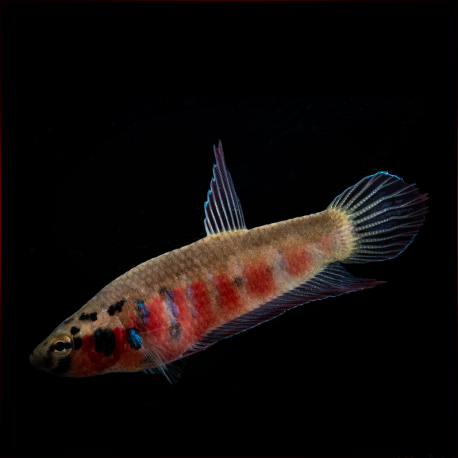More info
Datasheet
| Minimum Tank Size | 40 litres / 10.57 US gallons |
| Maximum Size | 4.2cm / 1.65inches |
| Temperature | 22°C / 71.60°F - 27°C / 80.60°F |
| Hardness | 1.01dgH / 18ppm - 5.04dgH / 90ppm |
| pH | 5.0-6.5 |
General Description
Betta Rubra, a species within the order Perciformes, is a labyrinth fish from the Osphronemidae family, with a typical size of up to 4.2 cm. Belonging to the Betta rubra group, it is distinguishable by certain features like the absence of vertical bars on the operculum and a distinctive anal-fin structure. This species is native to northwestern Sumatra, Indonesia, and is predominantly found in lowland habitats.
Aquarium Setup
When setting up an aquarium for Betta Rubra, it is recommended to provide ample cover with driftwood, roots, branches, and clay plant pots to create hiding spots. The addition of dried leaf litter aids in microbial growth for supplementary nutrition, especially for the fry. Dim lighting, aquatic plants like Microsorum, Taxiphyllum, or Cryptocoryne species, along with soft, acidic water conditions are ideal. A gentle air-powered sponge filter is suggested to mimic its natural habitat, and maintaining a layer of humid air above the water surface is crucial to meet the species' respiratory needs.
Behaviour
Betta Rubra is best kept alone or with very peaceful species due to its timid nature. It may exhibit aggression towards conspecifics, especially when housed in pairs or small groups. Compatibility with certain small cyprinids and loaches exists, but thorough research is advised before selecting tank mates. Some reports suggest the possibility of maintaining Betta Rubra in harem-type groups with a single male and several females, emphasizing the need for careful observation to prevent prolonged aggression.
Feeding and Diet
In the wild, Betta Rubra primarily feeds on insects and small invertebrates. In captivity, they readily accept dried foods but should be provided with a varied diet including live or frozen options like Daphnia, Artemia, or bloodworms. It is crucial to prevent overfeeding as Betta Rubra can be susceptible to obesity. Offering a mix of small live foods multiple times a day promotes their optimal health and coloration.
Reproduction & Dimorphism
Betta Rubra is a paternal mouthbrooder, requiring a separate breeding tank with a tight-fitting cover to maintain warm, humid conditions for proper fry development. During spawning, the male wraps around the female, transferring eggs to her anal fin for safeguarding. Unlike most mouthbrooding Betta species, the male collects the eggs post-spawning. Sexual dimorphism is evident in the species with males displaying brighter colors and longer fins compared to females.
Habitat and Distribution
Native to northwestern Sumatra in Indonesia, Betta Rubra is typically found in stagnant blackwater pools within peat swamp forests. The region's isolation due to geographic barriers has resulted in a high level of endemic species. Human activities like deforestation have impacted its habitat, with recorded distribution limited to specific areas like the Singkil region. Efforts have been made to ensure the conservation of Betta Rubra following periods of unrest in its natural habitat.
Etymology
The species name "Rubra" is derived from the Latin word for "red," likely referencing the vibrant coloration observed in some individuals.

